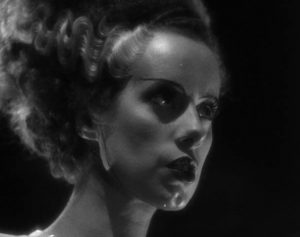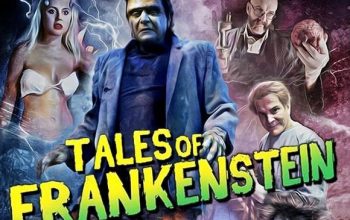Metropolis – 1927 (Part 2)
Last time we had a sort of general look at Metropolis as it relates to early Frankenstein cinema. It’s a big subject, and honestly I’m not going to cover all of it even with a supplementary essay, but I did want a closer look at two things. Firstly, religious symbolism and secondly the role of women in Fritz Lang’s Metropolis and James Whale’s Frankenstein and Bride of Frankenstein.
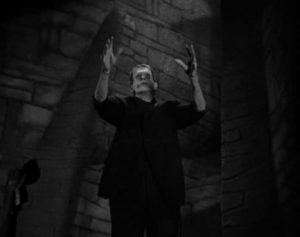
The novel Frankenstein is fascinating in that it is full of conscious religious imagery, but contains little sign of God’s actual presence. The Monster is compared frequently to both Adam and Satan. Both of these figures are creations that, like the Monster, rebel against their creator — with the difference being that neither of them is a match for God. However, the Monster is a match for Victor Frankenstein. This is why the various attempts to make Frankenstein into a Christian parable tend to be a little perfunctory. A story in which a being is angry at its creator, and able to stand eye to eye with said creator is simply unprecedented in the Bible. Imagine if Job could just get tired of arguing with God and just kick him in the shins. Completely different story.
This, ultimately, is the point of not only Frankenstein, but a huge chunk of the whole science fiction genre: how do we deal with the themes and ideas invoked by religion without invoking God?

Metropolis, unusually, doesn’t take this approach, and puts religion front and centre. Fritz Lang and his wife Thea von Harbow (who wrote the original novel and co-wrote the script) were both Christians, and Metropolis is filled with consciously Christian imagery. The demon Moloch, the Tower of Babel and the Whore of Babylon are all explicitly referenced. Even the metaphor the head and the hands has an obvious biblical parallel in the Epistle to the Corinthians.
But if Metropolis has obvious Biblical parallels, is who is Freder meant to be? The logical conclusion is that he’s a sort of Jesus figure. He comes down from on high, bringing love and mercy to those suffering below. At one point, after lifting the cruel burden from 11811’s shoulders, he is seemingly crucified by the machine he takes over. In the end, he takes on a very Jesus-like intermediary role.

But…if Freder is Jesus, doesn’t that make Frederson God? Strangely, it’s not such a stretch. He created the world of Metropolis and set its laws. We even see him consigning an minion who has disappointed him to the underworld. But… well, it’s odd for an explicitly Christian movie to make God such a pain in the arse as Metropolis makes Frederson.
Maria’s role even more confusing. Maria seems to be a fill-in for the Virgin Mary. Clue’s in the name. She’s introduced, a consciously innocent looking woman, tending a bunch of children who aren’t her own – simultaneously virginal and motherly. On the other hand her role as the Virgin is made awkward by her relationship with Freder. To say that a romantic relationship between the Jesus surrogate and the Mary surrogate complicates things is putting it mildly. I’m not religious, and frankly it weirds me out. I mean, ick.

On the other hand, the fact that Maria prepares the people for the coming of Freder, makes her (rather unexpectedly) a John the Baptist figure also. And the Maschinenmensch/false Maria (who was originally an imitation of Freder’s mother, there’s that Virgin Mary thing again) is explicitly compared to the Whore of Babylon from Revelation, bringing on the Apocalypse through sensual 1920s dancing. Maria is literally the Madonna/whore dichotomy rolled into a single character.
It’s deep–but also confusing and overwhelming. Perhaps it was best that, instead of trying to follow all these threads to their logical conclusions, we simply agree that society is saved by a handshake and move on.

This ambivalent, overloaded pile-up of Biblical significance also visible in James Whale’s Frankenstein. Before the story proper even begins, the narrator explains to us that Frankenstein is a religious story, and the moral is hubris. Frankenstein overstepped the boundaries that God set for him, and was punished.
Of course, the movie that follows makes no effort to back up the narrator’s claims. The Monster’s crimes come from a material source, located in his ‘evil brain’. Though Whale’s intention was different, Frankenstein is explicitly unpunished for his crimes. His arc ends with him injured, but basically all right, still planning to marry Elizabeth and with his doddering old father toasting his good health. In other words, Frankenstein’s punishment for his diabolical hubris is he has to go have a little bit of a lie down. As a Christian parable, Frankenstein lacks even the muddled intentions of Metropolis, and the attempt of the filmmakers to pass it off as a Christian parable is questionable at best.
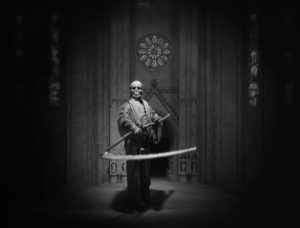
Whale goes in an even stranger religious direction in Bride of Frankenstein. The Monster wanders in the wilderness like an Old Testament prophet. He’s then cast in the Jesus role, explicitly crucified by people who ‘know not what they do.’ He goes into a tomb and emerges. Here his story diverges from Jesus’ in that when he comes out, it’s with the Devil (in the form of Pretorius) in tow. And yet, in the end — even as he’s destroying Frankenstein’s lab — he takes Frankenstein’s sins on himself, letting his creator and Elizabeth get away safely. Go in peace, Henry Frankenstein, and sin no more.
It’s probably fair to say that Lang’s Metropolis and Whale’s Frankenstein are two films which help themselves to a great deal of Christian iconography, without really being especially Christian.
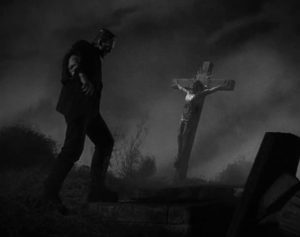
The Women of Metropolis and Frankenstein
Another interesting comparison between Whale’s Frankenstein and Lang’s Metropolis, is the role of women. Part of the issue with Metropolis is that there’s only really two woman characters, Maria… um… other Maria. Or maybe that’s one character. One and a half?
Anyway, Maria’s role is to lead the workers towards Freder and salvation. Elizabeth has a similar role in Frankenstein and Bride, acting as Frankenstein’s conscience. Maria and Elizabeth are both blameless women who are threatened – by Rotwang, by the Monster, by Pretorius.
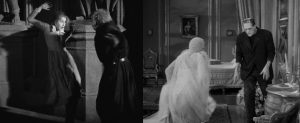
More interesting are the artificial women. The Maschinenmensch and the Bride run directly into a fairly typical (if dark) male fantasy: what if I could make a woman to spec?
Frederson’s answer to that question is ‘create a false Madonna’. Rotwang’s, answer is ‘build the Whore of Babylon.’ For Frankenstein and Pretorious, the answer is ‘create a new Eve.’ And for the poor old Monster, the answer is simply ‘Friend? Friend?’
So how does that go for these men that build their own women? In Metropolis, Maschinenmensch-Maria never gets to make her own mind up. Her role is set by Rotwang’s outmaneuvering of Frederson, so she becomes exactly what Rotwang wants. The Bride, on the other hand, is an explicit rejection of such an outcome. Three males (Frankenstein, Pretorious, and the Monster) are responsible for her creation, and she does precisely nothing that they wish of her.
 This thread runs through Frankensteinian film. The question of whether the female monster will obey or rebel is sexualised in a way that (Rocky Horror Picture Show aside) the male monster usually isn’t. Getting back to Metropolis, this is especially apparent. After all, if Rotwang wants his Maschinenmensch to be able to impersonate Maria, surely the best way to accomplish this would be having the robot copy Maria’s mannerisms. Instead it acts like a lonely middle aged man’s idea of what a twenty year old party-girl is like. It’s obedience to its maker is sexualised in a way that doesn’t even make much sense in context. Rotwang couldn’t imagine a different way for the Maschinenmensch to behave, and so neither could the Maschinenmensch herself.
This thread runs through Frankensteinian film. The question of whether the female monster will obey or rebel is sexualised in a way that (Rocky Horror Picture Show aside) the male monster usually isn’t. Getting back to Metropolis, this is especially apparent. After all, if Rotwang wants his Maschinenmensch to be able to impersonate Maria, surely the best way to accomplish this would be having the robot copy Maria’s mannerisms. Instead it acts like a lonely middle aged man’s idea of what a twenty year old party-girl is like. It’s obedience to its maker is sexualised in a way that doesn’t even make much sense in context. Rotwang couldn’t imagine a different way for the Maschinenmensch to behave, and so neither could the Maschinenmensch herself.
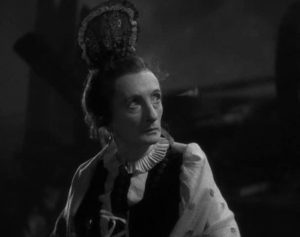
In conclusion, Lang and Whale are taking different sides on one of the great questions about artificial life: which would be worse, if artificial life rebelled against us, or if it obeyed us? This abstract argument takes on a more visceral dimension when the artificial being in question is presented female – and especially so when the filmmaker is a man.

